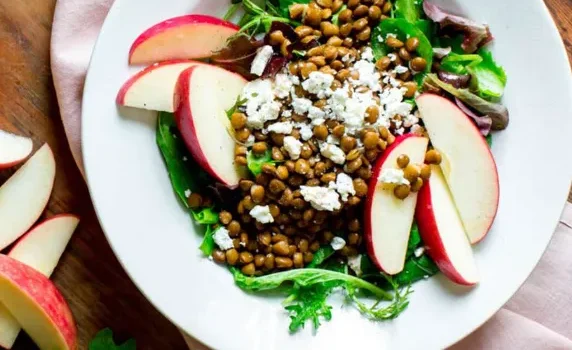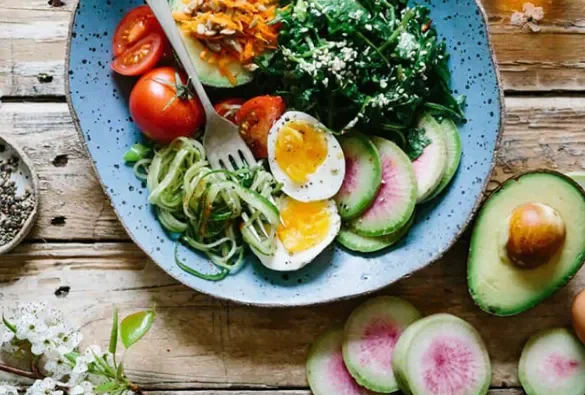
Eating heart-healthy meals is essential for managing cholesterol levels, but it doesn’t mean you have to sacrifice flavor. By making a few smart swaps and using some creative cooking techniques, you can enjoy delicious meals that support your heart health. Let’s dive into some simple ways to prepare low-cholesterol dishes without compromising on taste.
Rethink Your Protein Sources
When it comes to protein, the American Heart Association recommends focusing on lean fish, poultry, and plant-based options while limiting red and processed meats. Here’s how you can make healthier choices:
- Lean Cuts of Meat: Opt for extra-lean cuts of beef or pork, such as those labeled “loin” or “round.” These options are lower in saturated fat. Trim visible fat before cooking to further reduce fat content.
- Poultry: Choose skinless chicken or turkey breast to avoid the extra fat found in the skin. Ground turkey breast is also a great choice.
- Fish: Aim to include fatty fish like salmon or mackerel in your diet. These fish are rich in omega-3 fatty acids that support heart health. Be sure to avoid breaded fish, which adds unnecessary calories and fats.
- Meatless Options: Explore plant-based proteins like beans, lentils, tofu, or tempeh. These are not only cholesterol-free but also packed with nutrients.
Cooking Smart
The way you prepare your food can also make a big difference in how much fat ends up in your meal. Here are some cooking tips to reduce unhealthy fats:
- Roast, Bake, or Grill: Instead of frying, try roasting, baking, or grilling meats. These methods help drain excess fat and reduce calorie intake.
- Cook Ahead: For dishes like stews or soups, cook them a day ahead, chill them overnight, and skim off any solidified fat before reheating.
- Brown Meat in the Broiler: Use the broiler instead of sautéing to brown ground meat. This method helps fat drain away, keeping your meal leaner.
- Remove Poultry Skin: Remove the skin from chicken or turkey before cooking to cut down on saturated fat. You can also baste with wine or fruit juice to add moisture without extra fat.
- Steam or Sauté Veggies: Steam your vegetables or sauté them with a light spritz of oil instead of using heavy sauces.
Choose Lighter Dairy Options
If a recipe calls for high-fat dairy, swap in healthier alternatives:
- Milk: Use fat-free or low-fat milk instead of whole milk to lower the fat content of your dish.
- Greek Yogurt: For a creamy texture in sauces or soups, use fat-free Greek yogurt instead of heavy cream.
- Cheese: Opt for low-fat ricotta or part-skim mozzarella instead of full-fat cheeses. These swaps provide flavor without the added cholesterol.
Use Heart-Healthy Fats
Not all fats are bad for your heart. In fact, healthy fats can help improve cholesterol levels. Here are some heart-smart fats to incorporate into your cooking:
- Plant-Based Oils: Use olive, canola, or avocado oil for sautéing or stir-frying instead of butter, lard, or coconut oil. These oils are rich in monounsaturated fats, which can help lower LDL (“bad”) cholesterol.
- Nuts and Seeds: Adding walnuts, almonds, chia seeds, or flaxseeds to your meals provides healthy fats that support heart health and may help reduce cholesterol.
- Avocados: Incorporate avocados into your meals—whether in sandwiches, tacos, or salads. They’re rich in monounsaturated fats, which can help reduce LDL cholesterol and raise HDL (“good”) cholesterol.
- Omega-3 Fatty Acids: Fatty fish like salmon and tuna, along with fish oil supplements, are great sources of omega-3s, which can help reduce triglycerides and improve heart health.
Increase Fiber Intake
A high-fiber diet can help lower LDL cholesterol by binding to bile acids and eliminating them from the body. Here’s how to add more fiber to your diet:
- Whole Grains: Choose 100% whole grain breads, pasta, brown rice, and oatmeal over refined grains.
- Fruits and Vegetables: Snack on fresh fruits, veggies, beans, lentils, and nuts—each of these foods is packed with fiber.
- Baked Goods: Swap oil with applesauce or mashed bananas when baking to add moisture and reduce fat.
- Smoothies and Dips: Blend fruits and vegetables into smoothies, or add them to dips and sauces for a nutrient boost.
Add Flavor Without Extra Fat
Cooking low-cholesterol meals doesn’t mean sacrificing taste. You can enhance your dishes with herbs, spices, and other flavor boosters:
- Herbs: Fresh herbs like rosemary, basil, parsley, and cilantro add vibrant flavor to your dishes without added calories, salt, or fat.
- Spices: Experiment with cumin, turmeric, curry powder, paprika, and chili powder to spice up your meals. A little heat can transform a simple dish into something extraordinary.
- Alliums: Garlic, onions, and leeks contain compounds that help lower LDL cholesterol. They also bring a rich depth of flavor to any dish.
- Citrus: Add a burst of freshness with lemon, lime, or orange juice. These fruits can cut through fatty dishes and add a zesty punch.
- Vinegar: A splash of vinegar—whether balsamic, rice, or fruit-based—introduces a tangy note and can enhance the flavor of your salads and marinades.
Cooking Techniques for Maximum Flavor
How you cook can be just as important as what you cook. These methods allow you to enhance flavor without adding excess fat:
- Pan-Searing: Quickly cook food over high heat to create a golden, caramelized crust without the need for extra oil.
- Broiling: Use broiling to create a smoky, charred effect on meats, poultry, fish, and vegetables.
- Grilling: Grilling gives food a smoky flavor and crispy texture, perfect for meats, veggies, and even fruit.
- Steaming: Steam veggies, garlic, or ginger to preserve their fresh flavors while keeping fat content low.
- Roasting: Roasting brings out the natural sweetness in vegetables, such as carrots, squash, and Brussels sprouts, without needing excess fats.
Final Thoughts
Eating low-cholesterol meals doesn’t have to mean eating bland food. With some smart swaps and creative cooking techniques, you can enjoy flavorful meals that are both heart-healthy and delicious. Whether you’re trying to lower your cholesterol or simply want to eat healthier, these tips will help you cook meals that everyone will love without compromising on taste.












